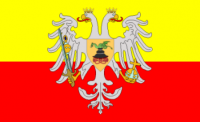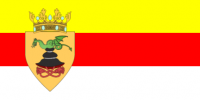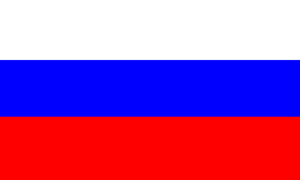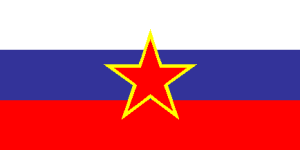Slovenia
| Conventional short name: | |
| Local: | Slovenija |
| English: | Slovenia |

| |

| |

| |
| Languages: | |
| Official: | Slovene |
| Others: | German, Dalmatian, Croatian, Istrian |
| Cities: | |
| Capital: | Ljubljana |
| Largest: | Ljubljana |
| Other: | Celje, Maribor, Murska Sobota |
| Prince: | Otto von Hapsburg |
| President: | Tomaž Hostnik |
| Independence: | from CSDS/Croatia |
| Declared: | 1996 |
| Recognized: | June 27, 2010 |
| Currency: | tolar |
GENERAL INFORMATION
Administration
Government
HOW GOVERNMENT IS ORGANIZED
Administrative Divisions
LIST OF ADMINISTRATIVE DIVISIONS
History
HISTORY OF THE NATION
Geography
GENERAL DESCRIPTION OF THE COUNTRIES GEOGRAPHY
Borders
North: Austria West: Istria, Italy South: Dalmatia East: Croatia, Hungary
Economy
RELEVANT ASPECTS OF THE NATION'S ECONOMICAL SECTOR, EXPORTED PRODUCTS, ETC...
Culture
RELEVANT ASPECTS OF THE NATION'S CULTURE
Languages
Religion
See also
The Olimpija Ljubljana football club escaped from Slovenia in 1996 following the complete annexation of Slovenia by Croatia. The players and staff received refugee status in Dalmatia, where the club is now settled in the city of Metlika, which has a sizeable Slovenian minority.
- The international community is quite conservative and reserved when it comes to recognising new states in general, and tried to convince Slovenia that it would be better off in union with Croatia than on its own. And so the premier of Nauru (11,000 inhabitants) was sent to Slovenia (1,3 mln inhabitants) in order to tell them that Slovenia was actually too small for become an independent state.
Slovenia did have a year as an independent Principality in 1917...
that Sanjak could make it thanks to strong pressure from the Islamic world, while Slovenia simply missed a strong ally (not much left with Germany and Austria preferring to cooperate with Croatia, while France, Castile and Leon and the Two Sicilies would rather support Dalmatia).
Dalmatia at the time was too occupied with her own problems. There was still Croatia to fight and then there was also the "Republic of Serb Kozara" to deal with too (which it dealt with in 1997 in an all-out Blitzkrieg called Operation Storm. However the Storm of *there* was not as merciless as the Storm of *here* which eliminated Serb Krajina, in that the Serb population was not forcibly expelled. A good 60-70% of the Serbs in the Kozara region did voluntarily go to Serbia though, and the ones who remained faced no problems so long as they abided by Dalmatian law and swore loyalty to the Republic as is required of all citizens). Anyway with these issues to deal with, Dalmatia really didn't have time to assist Slovenia in any real way, though they did give moral support. Since the end of the war, the government-in-exile of the Principality of Slovenia resides in Metlika in northern Dalmatia, since that town has the largest Slovene minority of any part of Dalmatia. Today Dalmatia does not recognise the incorporation of Slovenia into Croatia, and this is often a bone of contention between the two countries, though it seems unlikely they will go to war over it.
> And I assume the RTC may have sympathised with Slovenia, but not supported > her due to neutrality?
Kośkiny niemik kośkinu omiku Cutonór je omik Erdecze.
(Every enemy of every friend of the Germans is a friend of the RTC)
Dalmato-Slovene Relations During and After the Great Balkan War
In 1996, eight years after Bulgaria's declaration of independence set the CSDS on the downward spiral into civil war and dissolution, the Slovenian Soviet Republic declared independence from the CSDS under the leadership of Tomaž Hoštnik, who had been elected president in reaction to Franjo Tudjman's policies as CSDS president.
Hoštnik was a Slovene nationalist who started out not as a politician but as a musician; in 1982 he founded the well-known band Laibach, who immediately became popular throughout the underground scenes in the CSDS. By 1985, Laibach were a huge influence on Danubian youth, so agents of Directorate Three tried to solve the problem by having Hoštnik assassinated. This plan backfired, however, as an ethnic Slovene agent of Directorate Three sent word out through the criminal and underground network to Hoštnik, who thus prepared, was able to avoid assassination. In 1987, he was elected president of Slovenia (much to his surprise; he was reportedly surprised that the elections authorities had allowed him to run in the first place).
In 1996, Hoštnik declared the independence of the Principality of Slovenia, which Dalmatia immediately recognised - the only country in the world to do so. After Croatian forces crushed the fledgling state, Hoštnik and his government fled to the only visibly friendly state - Dalmatia - where they were permitted to establish a government-in-exile in the town of Metlika in northern Dalmatia, where there is a large ethnic Slovene minority. While Dalmatian law prohibits dual citizenship, and exception was made for the Slovenian Government-in-Exile, who hold both Dalmatian and Slovene citizenship (though naturally, travelling abroad they use their Dalmatian papers), and many ethnic-Slovene Dalmatians have symbollically taken Slovenian citizenship. The formation and continued existence of the Slovenian Government-in-Exile is a strong point of contention between Dalmatia and Croatia and is viewed as a serious impediment to the normalisation of relations between the two countries. The Croatian government has clearly said that no improvements can be foreseen in the relations of Croatia and Dalmatia unless Dalmatia withdraws its recognition of Slovenian independence and turns over the members of the Government-in-Exile to Croatia. Dalmatia has consistently refused this, knowing that some amount of relations must exist between the two countries and that Dalmatia - being far more industrialised with far better ports - is in a position of strength: Croatia needs Dalmatian industrial products and the use of her ports. Croatia recognises this too, which is why the two states haven't gone to war over the Slovenian question.
Beginning in 2000, informal and semi-informal discussions began about the possibility of creating an autonomous region for Slovenes inside Dalmatia. The debate raged on radio shows, television shows, in the print media and in sidewalk cafes. It is perhaps interesting to note that at the times when the debate reached a peak, so did, correspondingly, the amount of anti-Slovene and anti-Dalmatian rhetoric from the Croatian government; at the times it died down, the rhetoric died down as well. The question seems to have been given a final answer in 2003, after a formal State meeting between Dalmatian Prime Minister Aurial Ybl and Hoštnik on 27 June, Hoštnik went on Radio Dalmatia and made a speech in which he said the strong personal autonomy in Dalmatia is quite sufficient, that "Slovenia is a country, whether it has territory or not, because the Slovene nation is what makes the Slovene country. Wherever there is a Slovene, the piece of land he is standing on is Slovenia. Though the Ustasha flag may darken the skies of Ljubljana, she is still Slovenia, for Slovenes live there. Triglav is ours, he is on our national symbols and in our hearts - and he will see the day when the Slovene nation once again rises up, expels the oppressor, so that the Slovene country may once again have land, for Triglav - like the Slovene spirit - is immortal!" This radio broadcast, like all others made by Radio Dalmatia, was receivable in Slovenia.
For a week and a half before the speech there had been riots and general strikes in Ljubljana and Maribor, to which the Croatian authorities responded swiftly and harshly. Croatian Regent Tomislav Pavelit', in his Beginning-of-Summer speech, addressed the issue of increasing unrest of ethnic Slovenes, most recently displayed in riots in Ljubljana and Maribor: "It is with great distress that I see the events in Ljubljana and Maribor, which are futile attempts by outside powers to destabilise Croatia. Belgrade, Budapest, Raguza, the whole world - must take note that we will not stand by and allow foreigners to incite our people to fight against one another!". This, followed by Hoštnik's powerful and emotionally-charged speech, led to further rioting in Ljubljana, Maribor, Celje, Trst and other towns and cities.
Odds & Ends
- To date, the only person to have flown faster than sound is Karel Jagr.
- The international community is quite conservative and reserved when it comes to recognising new states in general, and tried to convince Slovenia that it would be better off in union with Croatia than on its own. And so the premier of Nauru (11,000 inhabitants) was sent to Slovenia (1,3 mln inhabitants) in order to tell them that Slovenia was actually too small for become an independent state. Slovenia did have a year as an independent Principality in 1917... that Sanjak could make it thanks to strong pressure from the Islamic world, while Slovenia simply missed a strong ally (not much left with Germany and Austria preferring to cooperate with Croatia, while France, Spain and the Italies would rather support Dalmatia). Dalmatia at the time was too occupied with her own problems. There was still Croatia to fight and then there was also the "Republic of Serb Kozara" to deal with too (which it dealt with in 1997 in an all-out Blitzkrieg called Operation Storm. However the Storm of *there* was not as merciless as the Storm of *here* which eliminated Serb Krajina, in that the Serb population was not forcibly expelled. A good 60-70% of the Serbs in the Kozara region did voluntarily go to Serbia though, and the ones who remained faced no problems so long as they abided by Dalmatian law and swore loyalty to the Republic as is required of all citizens). Anyway with these issues to deal with, Dalmatia really didn't have time to assist Slovenia in any real way, though they did give moral support. Since the end of the war, the government-in-exile of the Principality of Slovenia resides in Metlika in northern Dalmatia, since that town has the largest Slovene minority of any part of Dalmatia. Today Dalmatia does not recognise the incorporation of Slovenia into Croatia, and this is often a bone of contention between the two countries, though it seems unlikely they will go to war over it. > And I assume the RTC may have sympathised with Slovenia, but not supported > her due to neutrality? Kaszkun jeniemik kaszkunu amiku Tutonór jest amik Erdeki. (Every enemy of every friend of the Germans is a friend of the RTC)



